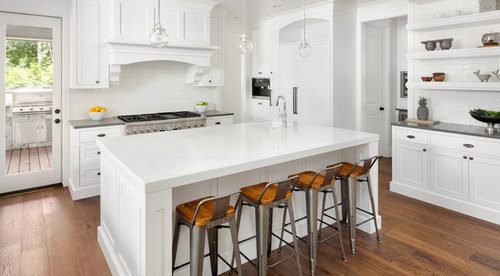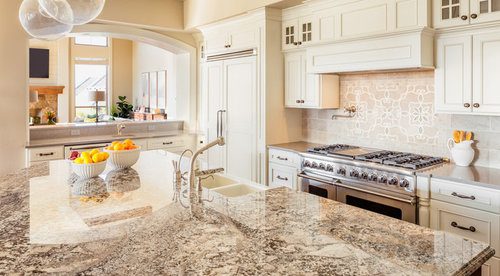Quartz vs Granite Countertops
Quartz Countertops
$3,500 - $3,760
(for 30 sq. ft., installed)
VS
Granite Countertops
$3,000 - $3,500
(for 30 sq. ft., installed)
Cost to install quartz or granite countertops varies greatly by region (and even by zip code).
To get free estimates from local contractors, please indicate yours.
Quartz Countertops

- Non-porous
- Uniform in color and texture
- More flexible
- Seams will be less obvious
- Sealing and resealing is not necessary
- More stain resistant
- More durable
- Adds to resale value
- More expensive
- Heavier
- Slabs are not as wide
- Must be repaired professionally
- Fades in sunlight
- Not for outdoor use
(for 30 sq. ft., installed)
Get free advice and estimates from countertop installers in your city.
Granite Countertops

- Natural stone
- Varied in color and texture
- Less expensive
- Available in wider slabs
- Small chips can be repaired at home
- Holds its color in direct sunlight and heat
- Adds to resale value
- Less expensive
- Samples do not represent actual colors
- Needs to be resealed periodically
- More brittle
- Seams will show
- Somewhat porous
(for 30 sq. ft., installed)
Get free advice and estimates from countertop installers in your city.
When you look at a photo of a new or remodeled kitchen or bathroom, certain features stand out — stainless steel kitchen appliances, an open and light-filled design, and hard-surface countertops. In a recent survey of the choices homeowners are making in designing new kitchens and baths, two particular types of countertops stand out among the options, granite and quartz countertops. We are going to point out the features of these two categories of countertops to help you decide if one of them will be right for your home.
Appearance
Quartz countertops are man-made of mostly ground natural quartz, also called engineered stone, mixed with seven to ten percent manufactured materials consisting of resins, polymers, and various pigments. Due to the pigments added to the ground quartz, the color and texture within a slab are consistent, giving quartz its uniform appearance from slab to slab within a production batch.
Granite countertops, on the other hand, are natural stone quarried from the earth in mines across the globe. Before it arrives at your local countertop showroom, it is cut to manageable-sized panels and polished to a mirror-like shine.
Granite is composed mainly of quartz and feldspar with a mixture of other minerals. The percentage of these ingredients combine to provide variations in color and pattern. Like a fingerprint, no two granite slabs will be the same. This natural variance makes it crucial to choose the exact piece you want installed rather than choosing from a sample, which may vary significantly from the final product that is installed. It is granite’s natural variation that often leads homeowners to choose it over quartz since quartz is mostly uniform in color and consistency. On the other hand, quartz’s consistency is something other owners appreciate. They see this as an opportunity to match their color scheme and design without fighting the natural busy pattern inconsistencies of granite.
Installation
A professional is required for the installation of granite or quartz. Granite, for example, must be carefully fabricated from the chosen slab to fit exactly and show its best features. It is more brittle than quartz, and a professional will guarantee the work being done. Quartz is heavier than granite. Because of this, a professional installer should inspect and perhaps prepare the cabinets where the quartz will rest.
Despite being heavier than granite, the resins and polymers in quartz make it a little more flexible, meaning it is somewhat easier to work with in the installation process. Neither installation can be classified as easy, however, since installers are contending with large, heavy slabs and cutting them carefully to fit an exact space.
Quartz is the better choice if a seam 1 is necessary during installation. This seam will not be as obvious with quartz, especially if the slab is dark and/or solid in color. Seams will always be visible with granite since matching one piece to another is impossible. On the other hand, seams may not always be necessary with granite since some pieces can be greater than 70 inches wide. Quartz, however, is usually not larger than 65 inches wide and is often only 56 inches. This means that large installations can be done easier with granite without requiring seaming.
The last step to installing granite countertops is the initial sealing of the stone. The installer will clean the slab completely and apply the sealant using a dry, lint-free cloth. These steps are not necessary with quartz since it is sealed during the manufacturing process.
Costs
Quartz countertops range in price from about $55 to $75 per square foot. Higher-quality varieties of quartz can cost $100 and up per square foot. For an average kitchen with 30 square feet of counters, quartz countertops will cost about $1,800. Labor will add approximately 22 percent of the material cost for about $360, while a sink cutout will cost around $100, and edging will run about $10 a linear foot, for a total of $3,760 installed.
Granite countertops range in price from about $40 to $75 per square foot. Granite is graded on a scale of 1 to 8, with 8 being the most exotic, rare, and expensive. These unique slabs of granite can cost much more per square foot - often up to $500 a foot. For an average kitchen with 30 square feet of counters, average-quality granite countertops will cost about $1,500. Labor will add approximately 22 percent of the material cost for about $330, with a sink cutout for $100 and edging at about $10 a linear foot for a total cost of $3,500 installed.
When possible, look for remnants for your countertops. These can save you a great deal of money for areas like small bathrooms. Just know that discount countertop outlets may feature flawed pieces of stone or quartz.
Radon
Radon 2 is the byproduct of the breakdown of radium and radon 2. It is a dangerous colorless and odorless gas, and it is harmful to humans, having been linked to lung cancer. Quartz countertops give off little to no radon 2, but a small amount is emitted from granite countertops. This does not mean that granite building materials are dangerous, however. The minute amount of radon 2 emitted from either of these household countertops is minimal and within the amounts considered safe.
Maintenance
Since quartz is sealed as part of its manufacturing process, resealing is not necessary. Quartz countertops should be cleaned with mild soap and water after use. Certain chemicals react with quartz, so read all label instructions carefully when using a new product. Please note that quartz is more stain resistant than granite, but even when properly sealed, it is not stain-proof. A spill of grape juice or tomato sauce still requires a quick clean up. Granite should also be washed with mild soap and water regularly and cleaned thoroughly after spills to avoid staining. Because the surface is somewhat porous, most granite installers recommend resealing countertops yearly.
Repairs to small chips in granite can be accomplished by the homeowner using a matching epoxy available from home improvement stores. Any crack or flaw larger than a peanut should be repaired by a professional. With quartz, a professional should always be called to fix a crack or chip.
Durability
Quartz countertops are highly durable because the resins and polymers that combine with the natural quartz give it a surface that is free of cracks and pores. Therefore, a properly maintained countertop of quartz can last the lifetime of the house.
Quartz is, however, susceptible to fading or changing color in direct sunlight. All quartz countertops should be protected from UV radiation. On the contrary, since granite is from the earth, sunlight and heat do not change its appearance.
Granite countertops are very strong and with proper use and maintenance can also last a lifetime. Natural stone can break or chip, however, if struck with a heavy object at the right angle. This is highly unlikely with regular use.
Environmental Impact
Quartz is by far the most environmentally friendly of the two choices. Granite must be quarried and transported to your home before installation, causing it to have a much larger carbon footprint. Quartz, however, is often manufactured nearby.
Outdoors
The same polymers and resins that make quartz the durable winner for indoor use will fade and discolor in direct light. It also does not perform well in heat and humidity. As a natural stone, granite is the superior choice for outdoor kitchens and other exterior uses or in areas not climate protected.
Resale Value
Both quartz and granite make a kitchen or bath look and feel more elegant and clean, but will they help sell a home? Experts say yes. Granite has a timeless look to it, and the varied colors and patterns in a countertop can stand any number of redecorations by future owners. On the other hand, quartz is the best thing since sliced bread in the real estate market right now. Its clean, sleek look is an instant selling point. In short, a homeowner can’t go wrong with either choice in terms of adding value to a home.
Remodeling Terms Cheat Sheet
Definitions in laymen's terms, cost considerations, pictures and things you need to know.See full cheat sheet.
How much does it cost to install quartz or granite countertops in my city?
Cost to install quartz or granite countertops varies greatly by region (and even by zip code).
To get free estimates from local contractors, please indicate yours.